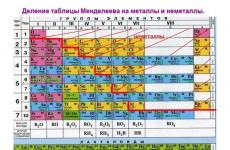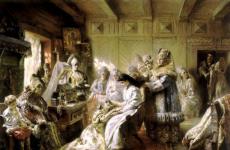Fedor Alekseevich transformations table. Pre-Petrine Reforms of Tsar Fyodor Alekseevich. Fedor son of Quiet Alekseevich
Historiography of government. There are 2 opposing points of view on this problem:
· According to some historians, this is the era of social-ec. and watered. crisis (Soloviev, Anisimov). They believe that the reasons were: the struggle of boyar groups for power, the church schism (which caused deep social upheavals), the lack of a developed economy in Russia, its lagging behind other countries;
· according to others, there was no crisis in Russia, the Russian state developed in the same directions along which Peter I would carry out his reforms (Klyuchevsky, Milyukov, Platonov). They rejected the concept of crisis and counted. That Peter's predecessors determined the main directions of his reforms.
Period from 1676 to 1682 (the reign of Fyodor Alekseevich) was called the “hidden kingdom”.
1. State reform management.
An “execution chamber” is created within the DB, the goals of which were: 1. prompt resolution of complex issues; 2. resolving issues between orders. (equivalent to the Senate of Peter I);
- reorganization of the activities of orders. Orders that had similar functions (military, financial) were united under the leadership of one official (equivalent to Peter's collegiums). The main official was the voivode. He received a salary for his service (= Peter's governors).
2. military reform. 1. military district reform(1679), the essence: all counties were united into 9 districts (Petrine provinces). The district was headed by one of the voivodes (Petrine governor). Each of the districts was assigned a certain number of troops, formed on the basis of dat people: 1 dat person - a soldier from 25 households (Petrine conscription and conscription). The entire population of the district paid a tax to the treasury for the maintenance of the army. 2. abolition of localism- 1682 - this is a decree according to which the obligation of the nobles to serve was confirmed, but service in the regiments of the districts was counted as military service. The term “regimental service” appears. The Russian army was 4/5 constant even before Peter I.
3. Reform of the State Duma. Reform of ranks and titles. For diplomats, for the army, for the boyars, for local government - each has its own system. The entire system fits into 35 ranks in a hierarchical plan (Peter I - Table of Ranks, 1721)
4. Tax reform. 1. Fedor abandons the land form of taxation (plow) and establishes a household system; 2. Some anlogues were always collected in their natural form. A unified system of weights and volumes is being introduced to collect taxes in kind; 3. The bulk of indirect taxes were abolished. Only one direct tax is introduced - for the maintenance of the army.
5. Education reform. It was planned to open an academy in Moscow (an academy is equivalent to a modern university). In April 1682, Fyodor Alekseevich signed a decree approving the “Privilege of the Moscow Academy”. Privilege is a charter. This academy was supposed to train personnel for the state system. management. The university was governed by a council of teachers, which elected the rector and deans. The faculty council was independent. All students were not under the jurisdiction of the state, but of the council of teachers. Representatives of all classes studied at the university, they were paid a scholarship on which they could live. At that time, the criterion for education was knowledge of Latin, because everything was published in it.
In 1687, Sophia opened the Slavic-Greek-Latin Academy in Moscow. It was the first higher secular institution (secular means that it was not associated with the church). It was not a university, but it (the academy) was the predecessor of the first universities in Russia.
The beginning of the reign of Fedor Alekseevich
The Tsar died in $1676 Alexey Mikhailovich, nicknamed by history The quietest. Tsar Alexei was married twice, the first time to Maria Miloslavskaya, after whose death from childbirth the king remarried, to Natalia Naryshkina. At the time of Alexei's death, several children from both marriages remained alive. The eldest were the daughters - Evdokia, Marfa, Sophia And Catherine, but they were not taken into account in the succession to the throne. The eldest son was Fedor Alekseevich. Then they walked Ivan Alekseevich And Feodosia Alekseevna. All these were Miloslavskaya’s children. From Naryshkina they were Peter, Natalya And Theodora, who died at the age of three.
After the death of Alexei Mikhailovich, Fyodor Alekseevich became the new tsar. He was then $14$ years old. The young king was in very poor health and was often sick. And after the death of his father, the struggle between the Miloslavsky and Naryshkin groups for influence began. The Miloslavskys were headed by a princess Sophia. The Naryshkins were headed by Alexei's widow Natalia.
Increasing throughout the $17th century. the tendency of autocracy at first under Feodor gave way to the influence of the nobility. The order of Secret Affairs was canceled, since the Boyar Duma was not privy to its activities. Played a particularly active role Artamon Matveev, one of the first Westerners in Russia. Since the king was ill at the beginning of his reign, they actually ruled - A. Matveev, Ivan Miloslavsky And Patriarch Joachim. But as soon as the tsar recovered, at the insistence of the Miloslavskys, Matveev was removed from business and sent into exile, since he sympathized with the Naryshkins.
Note 1
It is curious that the Miloslavskys wanted to completely remove the Naryshkins from the road by exiling the family from the court, but Fyodor opposed this. He probably loved his brother Petra, since he ordered toy military equipment to be built for him right in the chambers of the Kremlin.
Personality of the king
Having reached $18$ years at $1679$, Fedor Alekseevich was already actively involved in government activities.
The young king's tutor was Simeon of Polotsk, thanks to whom Fyodor was very interested in Western European culture, knew how to write poetry and was a brilliant musician. In addition, he understood European politics and knew Polish and Latin.
Note 2
Probably thanks to his education, which broadened Fyodor Alekseevich’s horizons, he looked at the situation in Russia from a different angle and realized its lag.
The Emperor gathered talented and energetic people around him:
- *Likhachev brothers,
- Ivan Yazykova,
- Vasily Golitsyn*.
Reforms
The so-called Execution Chamber, which dealt with controversial cases of other orders. She was the supreme body, reporting directly to the king. The young tsar stopped consulting with the boyars, deciding matters on his own. He demanded high-quality work from others and reduced the number of orders in order to get rid of red tape in business.
In military matters, regiments continued to be created "new order". The state was divided into military districts in 1678, this made it easier to collect troops and taxes. Previously, the militia gathered from all over the country in Moscow. Each district had to send a certain number of people to the army.
From now on, military affairs were led by the head of the united military orders.
A new one was built on the southern borders Serif line, to protect against Crimean raids. Vast vacant lands became relatively safe, they were given to landowners. At the same time, the search for runaway peasants intensified, because landowners, who received more and more land, needed people to cultivate them.
In $1676$ the compilation of new scribe books. In $1678, a population census was conducted. The form of taxation has changed. Instead of taxation, it was introduced household. A single tax was introduced, smaller in size, but already affecting everyone. It was collected from each yard “by stomach,” depending on income. Moreover, the government announced the amount, and the city government or rural community themselves distributed it among the households. This provided a certain amount of order in the taxation system.
Note 3
In $1682, Tsar Fyodor Alekseevich abolished the ancient parochial system. Abolition of localism meant that from now on a person could hold a military or civilian position for specific deeds and merits, and not by right of birth.
REFORM OF FEDOR ALEXEEVICH (1676-1682)
Fedor Alekseevich born on May 30, 1661 and ascended the throne on January 30, 1676. At the beginning of his reign, a fierce struggle broke out between the Naryshkins and the Miloslavskys. The latter first sent the governor to Verkhoturye, and then defrocked and exiled their closest adviser Alexei Mikhailovich to Pustozersk Artamon Matveev, who arranged the marriage of the Tsar with Natalya Kirillovna Naryshkina. At the same time, the Miloslavskys brought disgrace on the queen’s brothers and her few supporters. Nevertheless, a study of the documents shows that the young king did not have favorites who could be attributed with the authorship of personal decrees. There was no boyar-chancellor, and the dominance of any group in the Boyar Duma and in the orders cannot be traced.
Fyodor gleaned many ideas from the teacher of all, except Peter, the sons of Alexei Mikhailovich, Simeon of Polotsk: the idea of the state as a single whole, maintaining the existing social hierarchy, the need to take into account the interests of all classes, the possibility of promotion based on merit, etc. This determined the general course of the reform activities of the government of Fedor Alekseevich. During the judicial reform, fines were imposed for red tape over 100 days, retrial of cases already considered under Alexei Mikhailovich was prohibited, and self-harm executions were replaced by Siberia. Moreover, children might not follow their parents into exile. The conditions in prisons were improved, and it was ordered that people be released from them without bail or master's guarantees.
On January 27, 1679, two decrees were promulgated on reforms of local government and the tax system: numerous fiscal positions were abolished (all concentrated in the hands of the governor) and a long list of taxes. The letters clearly stated how much the new tax on the county and courtyard was reduced and how many arrears the tsar forgave. The local administration was thereby deprived of “feeding”, and a single customs eagle measure was established for the correct collection of grain.
After conducting inspections of the local army, the tsar knew that for each nobleman, on average, there was barely more than one tax yard. To rectify the situation, from 1679 to 1681, 30 thousand square meters were cut off from the Wild Field by the fortifications of the Izyum Line. km of fertile land. Somewhat later, the construction of the New Line from Verkhniy Lomov to Syzran was completed. At the expense of these lands, massive land distributions to the nobles were ensured. The Zemsky Sobor, convened by the tsar, abolished localism. At the same time, the Council resolved the issue of tax reform: all emergency fees were canceled and arrears were forgiven, the total amount of taxation was reduced and distributed among 10 categories in accordance with the economic development of the lands. The Tsar, in one of his decrees, expressed the hope that society would help the state take care of war invalids and all the poor, crippled and orphans. He widely distributed interest-free loans to Muscovites for the construction of houses and materials from the Order of Stone Affairs. At the same time, uniform measures were introduced for brick and white stone.
Fyodor Alekseevich approved the rules of the General Land Survey on March 17, 1682, when he was already mortally ill. He also failed to complete the reform of the church aimed at Christianizing the East. Mass conversions of Muslims and other faiths were accompanied by generous grants from the newly baptized tribal nobility. At the same time, the baptized representatives of the tax-paying classes of the Tatars, Mordovians and other peoples were declared freedom from the landowners who had not had time to convert to Orthodoxy. By the winter of 1682, it was announced that local feudal lords who “did not know the faith” would be forever deprived of their nobility.
In the history of Russia it is difficult to find an autocrat about whom not only the general reader, but also specialist historians knew as little as about the son of Alexei Mikhailovich and the elder brother of Peter I - Tsar Fedor (1676-1682).
It's not that documents are missing. The state archives of the Russian state have been preserved surprisingly well over the years. Fyodor’s reign was not “offended” by his contemporaries - chroniclers, memoirists and court writers, foreign travelers and diplomats, and the ubiquitous (even then!) newspapermen.
Both the officials who documented the state activities of Fyodor Alekseevich and the witnesses of his reign had something to write about. When, as a result of a fierce court struggle, the boyars elevated 15-year-old Fyodor to the throne of Alexei’s rightful heir, they were convinced that they would not be able to rule from behind the back of the puppet king. The educated, energetic and God-fearing tsar was so successful in his reform activities within a few years and so frightened the opposition that he doomed himself to a palace coup and an evil silence after his death.
It is clear that the relatives and minions of the new tsar sought to “clean” from the pages of Russian history the memory of the years of Fyodor’s reign, to hide the failed conspiracies and (especially!) the main, successful one, which brought Peter I to power. The most bitter thing in the history of Fyodor’s reign Alekseevich was that it was the elder brother who began the reforms that allowed the youngest of the sons of Alexei the Quiet to call himself the First, the Great, the Father of the Fatherland and, finally, the All-Russian Emperor. Fyodor began and successfully carried out reforms without, like Peter I, flooding the country with blood, without reducing its population by almost a quarter, without kowtowing to the West, without assigning the powerful state the role of a raw material appendage of Europe - and at the same time without frightening the European man in the street with the image of a terrible and the unpredictable “Russian bear”...
The Muse of History, Clio, is shy and conservative. I am ashamed because science, whose content has long been of interest to the authorities, has many sins on its conscience, the main one of which is deceiving the reader. Conservative, because, according to professional historian Anatole France, “historians rewrite each other. Thus, they avoid unnecessary work and accusations of arrogance.”
The reign of his elder brother Peter I provided an excellent example of these qualities of Russian and world historiography.
The six-year reign of Tsar Fyodor Alekseevich was extremely rich in events and decisions that were most important for the fate of Russia. Nevertheless, for centuries the personality of the reformer sovereign remained “in the shadow” of his younger brother, who was placed by the conspirators on his still warm throne and who actually reached the helm of power only in 1695.
Fyodor Alekseevich decisively led Russia out of the difficult and bloody war with the Ottoman Empire, and then radically reformed the army, making 3/4 of it regular. He carried out a general census, introduced unified taxation and reduced taxes three times, each time achieving a more equitable distribution. In the end, the tsar convened elected representatives from taxpayers to the Zemsky Sobor, so that the people themselves could decide how to pay taxes and fulfill state duties correctly “and not as a burden.”
The entire state apparatus, from the Boyar Duma to local government, was reformed to the great delight of the subjects, who had the opportunity with their own hands to destroy the countless nests of officials - bribe-takers and robbers. The sovereign took away access to finance from local governors, deprived them of “feeding” and put them on a salary. He introduced a unified system of ranks in the army (in general terms preserved to this day) and among diplomats, and abolished localism.
For the first time in Russia, Fyodor Alekseevich officially appointed a government (the Execution Chamber), taking a major step towards separating the executive from the legislative. The tsar struggled with judicial red tape from the first days of his reign, managing to temporarily establish “justice in the courts.” He eradicated the custom of endless pre-trial detention, brought order to prisons and abolished self-harm executions (reintroduced by Peter I).
The country's first charity homes for veterans, sick and disabled people were built with Fyodor Alekseevich's personal funds. Interest-free loans to citizens and the provision of resources from the Stone Affairs Order renewed Moscow - under Fyodor, 10 thousand stone buildings were erected in the capital. The Tsar introduced European dress and linear notes at court, and Russian music, painting, architecture and poetry flourished under him. Fyodor Alekseevich personally practiced these arts, along with the humanities and horse breeding.
Book lovers are especially interested in the unique phenomenon of his reign - a large and very effective independent publishing house with government funding, built with the latest technology. The latter developed so effectively that already during the war with the Turks, the Russian army received not only the first hand grenades and unified field artillery in Europe, but also “screw guns”, which even then were simply called “rifles”.
Historians should have noted that Russia during the time of Feodor was a powerful and prosperous power, recognized on the world stage as an empire. Its army at this time became one of the most powerful in Eurasia. Over the course of several years, the fortified border moved far to the south in the European part, the Russians received thousands of square kilometers of fertile and well-protected land.
Establishing the concept of Russia as a great Orthodox power, a guarantor of peace and justice for all peoples on the territory from the Baltic to the Pacific Ocean, the Tsar energetically defended its interests in international relations, putting our state on the same level as the world's leading empires.
Guided by the idea that the power and glory of the state are based on the wealth, security and enlightenment of each subject, Fyodor Alekseevich enriched the country with reasonable measures, significantly replenishing the treasury by reducing the tax burden and optimizing government spending.
The tsar managed to approve the basic principles of organizing a financially autonomous Moscow University, independent of the authorities, whose students could not only be drafted into the army, but also arrested without the permission of the academic council. Among the reforms prepared by Fyodor Alekseevich were the establishment of vocational schools for orphans and poor children, the multiple multiplication of dioceses of the Russian Orthodox Church, the introduction of a unified system of government officials, and the publication of the first scientific history of Russia.
The far from complete list of major events and transformations carried out during the reign of Fyodor Alekseevich is enough to pay close attention to the personality of the autocrat, who for the first time in the history of the ruling family in Russia received a higher education in the humanities.
Archives and publications of documents are filled with very energetic “personal” (personal) decrees of Tsar Feodor on the most important issues of Russian politics and economics. At the autocrat's request, government agencies, politicians and the military compiled detailed reports, analytical reviews, maps and plans, on the basis of which the tsar made bold strategic decisions and developed reform projects, many of which he was able to implement.
Nevertheless, historians continue to repeat the tale about the “weak and sickly” sovereign, who supposedly did not make any independent decisions. But if it was not Tsar Fedor who ruled the country, then who stood behind him? — The authors of historical works did not have an answer to this, and not by chance.
Under the sovereign there was not only no clear favorite or “first minister” (as was always the case under his father Alexei Tishaysh, and then under his sister Sophia, stepmother Natalia and brother Peter). Changes in the composition of Fyodor’s entourage and the distribution of leadership positions indicate that neither a specific personality of the “gray cardinal” nor a specific group stood behind the tsar.
Some of the king's plans had supporters among aristocrats, statesmen and generals. For example, the future chancellor boyar Prince Vasily Vasilyevich Golitsyn, whose idea Fyodor Alekseevich supported, giving a secret order to the commander of the Russian army to destroy Chigirin, a bone of contention between Russia and Turkey (1678), in order to lead the country out of a ruinous war. Or the famous general Grigory Ivanovich Kosagov, whose plan to decisively advance the fortified border of Russia to the south was approved by the tsar, contrary to the opinion of a number of influential courtiers.
Documents preserved in the archives indicate that these and other strategic decisions were made by the king after a very serious study of all relevant materials.
There is some irony in the fact that historians, who actively use in their work analytical materials and collections of documents on specific problems, prepared at one time for Tsar Feodor, continue to pretend that all this arose by itself. After all, clerks of the 17th century. clearly indicated for whom, when and why the certificate was required! Moreover, in his clear and precise decrees, especially those related to the “public benefit,” the sovereign often considered it necessary to reveal the essence of the problem, explain what he wanted to achieve and how exactly his decision would affect the interests of broad sections of his subjects.
Of course, for a correct understanding of the inner world of the tsar-reformer, the logic of his decisions alone, arising from the content of the documents reviewed by the sovereign and the motivational part of the decrees, is not enough. Man is not a logical machine; he is influenced by many circumstances, which the historian has to reconstruct from the entire huge mass of original documents and evidence of that time. And most importantly, each of us (and we will not deny this to Tsar Fedor) has our own very complex inner world, our own tastes, beliefs and preferences that have developed since childhood.
The personal life of the tsar, who was unreasonably portrayed as weak, sick and incapable of anything, turned out to be surprisingly rich and even romantic.

The wedding of Fyodor Alekseevich with his first wife Agafya Semyonovna Grushetskaya

Agafya Semyonovna Grushetskaya(1663-14 July (24 July) 1681) - Russian queen, from the noble family of Grushetsky, daughter of the nobleman governor Semyon Fedorovich Grushetsky. From July 18 (July 28), 1680, the wife of Tsar Fyodor Alekseevich (05/30/1661 - 04/27/1682). She gave birth to her only child, who died in infancy, Tsarevich Ilya Fedorovich (July 11 (July 21) - July 21 (July 31), 1681). She died on the third day after giving birth on July 14 (July 24), 1681 from fever. She was buried in the Ascension Monastery. She was reburied in the underground chamber of the southern extension of the Archangel Cathedral in 1929.
Agafya was the daughter of a Smolensk nobleman of Polish origin, a Moscow nobleman, Chernavsky governor Semyon Fedorovich Grushetsky. Agafya Semyonovna knew how to read and write, spoke fluent Polish, understood Latin books, had a fairly clear understanding of life in the West and even understood if French was spoken in front of her; played the harpsichord. Her nanny was Polish. She was one of the most beautiful girls of her time. “The face is like a heavenly angel, and the mind is bright” - this is what they wrote about the blue-eyed beauty Agafya. The young 18-year-old Tsar Fyodor Alekseevich noticed her in the crowd during a religious procession, on Easter, in the spring of 1680. When he passed by her, she fainted, as this face was shown to her by an old sorceress during a mystical ritual of prediction. The king, violating decorum, abandoned the religious procession and rushed to the young beauty’s aid. The face of the emotionless girl struck the prince with its beauty and her features were strongly etched in his memory and heart. He instructed Yazykov, Ivan Maksimovich, to make inquiries about her. It turned out that this was Agafya Semenovna Grushetskaya and that she lived with her mother in the house of her uncle, Duma nobleman Semyon Ivanovich Zaborovsky (her mother’s brother), who until 1677 ruled the Monastic Prikaz. The young Tsar Fedor ordered her to be handed over to his uncle, Zaborovsky, “so that he would keep that niece of his and not marry her off without a decree.”
Not wanting to violate ancient customs, the tsar ordered to convene all the beautiful girls from the highest circle for a bride viewing and chose Grushetskaya from among them. In the palace records, the names of those girls who were brought in July 1680 to choose a bride from among them were preserved. There are about 20 of them all. A list of some rejected girls who were returned to their homes after the viewing: the daughters of Fyodor Kurakin, Marfa and Anna Fedorovna; daughter of Ivan Khitrovo, Vasilisa; daughter of the okolnichy, Prince Danila the Great - Galina; daughter of the steward, Prince Nikita of Rostov; two daughters of princes Semyon and Alexei of Zvenigorod; daughters of princes Semyon Lvov, Volodymyr Volkonsky. All the girls who were at those shows were given the sovereign's salary: four zarbavas (a type of brocade) - price 101 rubles; 40 arsh. Otlasov; 70 arsh. Obyarey (thick silk fabric); 180 arsh. Kamok.
Having learned about the tsar’s choice, one of his closest relatives, Ivan Ilyich Miloslavsky, began to spread the most ridiculous inventions about the tsar’s bride in order to prevent an ordinary noblewoman from appearing in the leading roles in the tsar’s palace. However, he only achieved that the king’s wrath fell upon him, and only the intercession of Agafya Semyonovna saved him from disgrace. The Tsar again allowed Miloslavsky to appear at court, but his influence did not return. The tsar's marriage was arranged by his favorites - I. M. Yazykov and A. T. Likhachev. “People are new and humble, they owed their approach to Fyodor only to their dexterity and insinuation, who became very attached to them. In the struggle for dominance with the Miloslavskys, who were backed by the Tsar’s sisters and aunts, the new favorites needed strong support, and only the young Tsarina could provide it to them, as Naryshkina Matveeva had done before. The Miloslavskys directly attributed Fedor’s marriage to their intrigue.” And indeed, after the wedding, the influence of Likhachev and Yazykov increased sharply, and the Miloslavskys retreated into the shadows. Tsar's bed-keeper I.M. Yazykov May 8, 1681 He was granted a boyar status.
The very logic of the study forced the author to construct a narrative about the affairs of government and state problems around the inner world, family and other personal relationships of the reformer king. The upbringing, hobbies, inclinations and passions of the Tsarevich, and then Tsar Fyodor Alekseevich, both in life and in the book, are closely intertwined with the fundamental, often dramatic decisions he made about the fate of the Russian state.
How can we reliably reveal this inner world of a person who lived an unusual life for us in the distant 17th century? This is not an easy question for a historian. First of all, one should identify and study all the circumstances of Fedor’s life, the details of his environment, the books he read, find everything that can be known about his faith and beliefs, his loved ones, friends and toys, hobbies and likes. However, the only criterion that the picture of the hero’s inner world reconstructed in such a complex way (and inevitably having lacunae) is correct is its completeness and harmony, i.e. ultimately - persuasiveness for the reader.
I didn't make a mistake. The assessment by the general reader of the picture of the inner world of Tsar Fyodor Alekseevich and Russia of his era recreated in the book objectively has no less weight than the opinion of professional historians. At the high level of generalization, which in this case had to be resorted to, the ingenious methods of processing sources used in the early stages of the work no longer matter. To evaluate the author’s logic, no special knowledge is required: this is a property of generalizing works on history, which often forces scientists in fear to refuse to write them and even claim that such works are not scientific enough.
I am sure that books, the content of which is absolutely clear to the reader, are the natural result and goal of all special historical research, generally giving them meaning. If the result of the research cannot be presented in terms clear to every literate person, if the logic of its construction is incomprehensible, and the resulting picture is unconvincing, then the work is not completed or the historian did it poorly.
It gave me great pleasure to write this book about the mysterious and romantic period of Russian History, in which the first and quite true, although not officially declared, emperor lived and worked hard.
I hope that you, dear reader, will fully experience this joy of learning new things.
Fyodor Alekseevich was born on May 30, 1661 in Moscow. Father - Tsar Alexei Mikhailovich, mother - Maria Ilyinichna Miloslavskaya. Simeon of Polotsk, who was known in Rus' as an educator and who paid great attention to the education of the future tsar, took an active part in the education of Fyodor Alekseevich. Despite the fact that Fedor was not in good health, he was interested in sciences, arts, horse breeding and archery. He spoke excellent Polish and knew Latin. The problem became that Fedor was very susceptible to all sorts of influences.
This trait was actively used by the enemies of Alexei Mikhailovich’s second wife, Natalya Kirillovna. The entire reign of Fyodor Alekseevich was marked by the fierce struggle of some boyar groups against others for closeness to the tsar.
Nevertheless, the heir showed independence in choosing his wives. Initially, he himself chose Agafya Semyonovna Grushetskaya, the daughter of a Smolensk nobleman, as his wife, and after her death during childbirth, his choice settled on the humble beauty Marfa Matveevna Apraksina.
Domestic policy of Fedor Alekseevich
Despite the active influence of his close associates and relatives, the king independently brought significant changes to the internal life of the country. Initially, he conducted a general census of the population and, on its basis, began a tax reform, replacing the many taxes that existed at that time with a single household taxation (1679). All government institutions received a unified work schedule, and the state apparatus grew.
Expanding it, Fedor Alekseevich unified the tasks of departmental orders. The reforms also affected local authorities. Local governors strengthened their power, but lost their financial functions. The “feeding” system, which was the main pretext for all local abuses, was eliminated.
1679 was the year of reorganization of the army. In fact, a regular army appeared, and all nobles had to serve in regiments. Only the Cossacks remained outside the regular army.
Innovations affected social and cultural life. The secular Upper Printing House appeared in Moscow. A charity home for the disabled was created, and an orphanage opened for orphans, where they taught literacy and crafts. During his short reign, the tsar signed the document “Privileges of the Moscow Academy,” which outlined the principles of the structure of the future first higher educational institution of the Russian kingdom - the Slavic-Greek-Latin Academy. Long before, he tried to introduce European clothing at court and was favorable towards new trends in literature and painting.
Foreign policy of Fedor Alekseevich
During the short period of his reign, Fyodor Alekseevich managed to make peace after the war of 1672-1681 with Turkey. This peace stipulated that Türkiye would recognize Left Bank Ukraine as the possession of Russia.
Fyodor Alekseevich Romanov died on April 27, 1682 in Moscow. The death of the king was received ambiguously. Unrest began in the capital. The attitude of his subjects towards the king was very good, and the rebels accused the courtiers of his murder. This was probably the only such case in Russian history.






